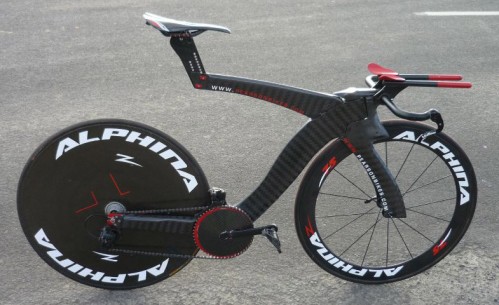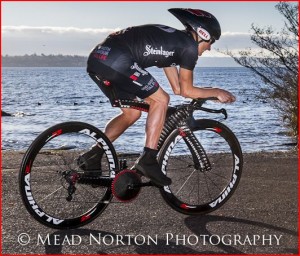 My post from last year about pro triathlete TJ Tollakson’s 1996 Zipp bike is still generating a fair bit of traffic here at Bicycle Design, so I assume there must be some renewed interest in beam frames. If the reaction to Graeme Pearson’s Z1-Eleven frame design on the Slowtwitch forum is any indication, there is definitely interest and excitement…among triathletes at least. As mentioned in the Slowtwitch thread, Tollakson himself is coming out with a new beam frame bike next year. Also, the Cycpro tri bikes are picking up in sales, indicating that there is a market for TT/tri bike designs that will never earn a silly little UCI sticker.
My post from last year about pro triathlete TJ Tollakson’s 1996 Zipp bike is still generating a fair bit of traffic here at Bicycle Design, so I assume there must be some renewed interest in beam frames. If the reaction to Graeme Pearson’s Z1-Eleven frame design on the Slowtwitch forum is any indication, there is definitely interest and excitement…among triathletes at least. As mentioned in the Slowtwitch thread, Tollakson himself is coming out with a new beam frame bike next year. Also, the Cycpro tri bikes are picking up in sales, indicating that there is a market for TT/tri bike designs that will never earn a silly little UCI sticker.
 For triathlons that are not governed by the UCI’s equipment regulations, beam designs may make sense. I am definitely not an expert on aerodynamics, so I don’t know how a disc wheel equipped Pearson Z1-Eleven would compare with something like a Specialized Shiv or a Cervelo P5 in the wind tunnel (or a real world race against the clock). The frame certainly looks aero, but I suspect that eliminating the seat tube introduces new issues to workout with air flow over the rear wheel. I would love to hear thoughts about that from any of you who are more knowledgeable on the subject of frame aerodynamics. Beam bikes have always been about more than just aerodynamics though. Comfort is a big part of it, and as Graeme points out, his design “features a beam that can be tuned for flex or locked rigid”.
For triathlons that are not governed by the UCI’s equipment regulations, beam designs may make sense. I am definitely not an expert on aerodynamics, so I don’t know how a disc wheel equipped Pearson Z1-Eleven would compare with something like a Specialized Shiv or a Cervelo P5 in the wind tunnel (or a real world race against the clock). The frame certainly looks aero, but I suspect that eliminating the seat tube introduces new issues to workout with air flow over the rear wheel. I would love to hear thoughts about that from any of you who are more knowledgeable on the subject of frame aerodynamics. Beam bikes have always been about more than just aerodynamics though. Comfort is a big part of it, and as Graeme points out, his design “features a beam that can be tuned for flex or locked rigid”.
Pearson will offer the Z1-Eleven frame in standard version and a “radical aero” version (shown here), which features an “integrated aerodynamic front end”, and forks that “have hidden minimalist carbon fiber V- brakes”. Check out the Pearson Bikes website for more information about the bikes, and the cars that Graeme also designs.
So what do you think? Not just about the Z1-Eleven, but about these types of frame designs in general. If they make inroads in the sport of triathlon, what are the chances that we will see a change to the UCI’s diamond frame requirement as dictated by the Lugano Charter? I won’t hold my breath, but Pat and the gang are working to improve the organization’s image among cycling fans. Who knows? Stranger things have happened.
Images provided by Graeme Pearson

Leave a Reply